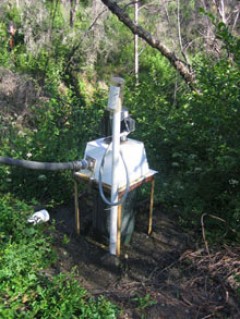 Editor’s note: I originally wrote this post for Blue Living Ideas, but I thought our readers might find it interesting.
Editor’s note: I originally wrote this post for Blue Living Ideas, but I thought our readers might find it interesting.
As a follow up to Sean’s post on Micro Hydro Essentials, I thought I would share an overview of my system, which has powered my home for over 13 years. We are fortunate to live on rural mountain property in Northern California with a creek that is not seasonal, although the volume of water does drop significantly during the arid months of summer. The beauty of hydro power is that it produces power 24 hours a day and is not dependent upon weather patterns, such as sun and wind. The drawbacks are having to maintain the system by cleaning the intake and dealing with varying creek flows.
17 years ago, my alternative power system consisted of one solar panel, one golf cart battery, one DC light, and one DC car stereo. Today, I live in a modern off-the-grid home complete with many large energy-using electrical appliances, such as a washing machine, air conditioner, refrigerator, vacuum cleaner, dishwasher, and baseboard heaters. Using these appliances off-the-grid is only possible by limiting their usage to one at a time, with the exception of the refrigerator (which remains on 24 hours a day). Unlike grid-connected homes, where it is common to see multiple large loads running simultaneously, most people living-off-the grid cannot run their washing machine while vacuuming, their heaters while washing dishes, etc. Alternative home energy systems are limited to the amount of power stored in the battery bank and what is being currently produced via wind, water, and/or sun for available power. Since hydro systems provide power continuously, the battery bank does not need to be as large as with other alternative energy systems.
Our system consist of approximately 2500 feet of two inch PVC pipe from intake to turbine. We “borrow” water from our creek which is diverted back to the creek after running through the turbine. At the bottom of the pipe, we have 230 PSI for our static water pressure (valve closed, not running). Our dynamic pressure (running pressure) changes to 185 PSI from pipe friction loss. Four inch pipe would greatly reduce this friction loss; however, the cost is prohibitive for us.
We run a turgo wheel coupled to a three phase induction motor that produces 220 volt, unregulated, “wild” AC power, which is sent long distance (1500 feet) from the creek to our power shed. This power cannot be used directly in appliances because it is unregulated, but it can be used for baseboard heaters and diversion loads, such as a hot water heating element. Our system differs from most micro hydro systems which produce DC power requiring the turbine be located close to the home because of line loss and cable size needed for direct current. To get the most head (vertical fall from intake to turbine), our wheel has to be located at the bottom of our property or else we would make very little power using a traditional DC micro hydro system close to our home (200 watts). With micro hydro systems, high head is more important than water flow for producing maximum power. Low head, high flow is hard to harness.
Once the “wild” electricity reaches our power shed, it is transformed and rectified to DC battery voltage and stored in our batteries like a typical alternative energy system. We then invert the power back to regulated alternating current through an inverter to use in our home. Excess power when the batteries are full is diverted to baseboard heaters in the house in winter and heat sink in the power shed in summer.
We make about 2 KW continuously with our micro-hydro system. This is ample power for a family of four using CFLs, energy-saving appliances, etc.; however, there are times when our power is down: large winter storms that fill the creek with leaves, and push the intake out of the water; creek levels drop in the summer and the dam needs rebuilding, etc. One thing that is nice about having your own power system is that when it is down, it is within your own power to go and fix. You don’t have to wait for the power company to rescue you, but this often means you are standing waste deep in freezing water during a storm. This whole micro-hydro system costs approximately $11,000, including pipe, wire, inverter, batteries, etc., but we haven’t paid a bill to a a power company in over 17 years!
[…] This post was mentioned on Twitter by ecochildsplay, Matthew Thomas Kemp. Matthew Thomas Kemp said: Living Off the Grid Our Micro Hydro Alternative Energy System http://bit.ly/cFc0hq […]